Knowde Enhanced TDS
Identification & Functionality
- Chemical Name
- Cleaning Ingredients Functions
- CAS No.
- 255830-15-0
- EC No.
- 700-903-6
- Technologies
- Product Families
- Composition
Amino-tri(methylenephosphonic)
Features & Benefits
- HII Features
- Properties
SEQUION CLR is a phosphonic acid of improved performance, characterized by:
- complete stability against chlorine-releasing agents;
- easy handling and excellent solubility in alkaline formulations (also in 50% NaOH);
- very good compatibility with quaternary ammonium compounds;
- excellent performance even in presence of high magnesium water-hardness.
SEQUION CLR possesses also the typical properties of phosphonates, namely:
- Threshold effect Inhibition of salt precipitation in super-saturated solutions of inorganic salts (CaCOs, CaSO4) using only substoichiometric quanitites of inhibitor into the solution.
- Chelation Formation of soluble complexes with metal ions.
- Deflocculation Stabilizing effect on colloidal suspensions.
- Corrosion inhibition Protection of metal surfaces in contact with liquids.
- Resistance to hydrolysis
- It doesnt decompose in aqueous solutions even under extreme pH and temperature conditions.
Applications & Uses
- Markets
- Applications
- Home Care Applications
- I&I Cleaning Applications
- Applications
Characteristics described above make SEQUION CLR suitable for all the applications of common sequestering agents/precipitation inhibitors, but the product may also be conveniently utilized in the following areas:
Sanitization
Due to its resistance to chlorine and excellent solubility in alkali, SEQUION CLR is recommended as low-dosage additive with low phosphorus content in sanitizing formulations for the following fields:- bottle washing
- dairy industry
- zootechnic breeding
- food manufacturing (equipment containers)
- wine industry
- sanitization in general
Typical formulations for these areas usually contain sodium hypochlorite and caustic soda, with the addition, in some cases, of silicate, carbonate, and sodium tripolyphosphate. Two indicative liquid formulations used for sanitizing and washing of equipment and containers used in food applications are given below:
Formulation 1
- NaCIO (13%) - 30-40 %
- NaOH (50%) - 16-24 %
- Na2SiOs - 10-20%
- Sequion CLR - 1-5 %
- H2O - As needed to 100%
Dishwashing
SEQUION CLR, liquid or in powder form, is used in formulations for dishwashing machines as partial substitute for STP so to reduce the total amOunt of phosphorus which contributes
to eutrophication. SEQUION CLR is stable in presence of chloroisocyanurate salts and to hypochlorite, that are often contained in such formulations. It is used as de-scaling additive at 2-3% concentrations. An indicative, liquid formulation used for industrial dishwashers is given below:- NaCIO (13%) - 16 %
- Na2SiO3 (40 %) - 16 %
- KOH (50%) - 6%
- Sequion CLR - 2 %
- H20 - As needed to 100%
Properties
- Physical Form
- Appearance
- Colorless/Light yellow liquid
- Soluble in
- Water
- Typical Properties
| Value | Units | Test Method / Conditions | |
| Active Acid Content (as ATMP N-oxide acid) | 24.5 | % | — |
| Density (20°C) | 1.44 | g/cm | — |
| pH Value | 10.0 | — | — |
| Sequestering Power (pH 10, CaCOs per/g of product) | 237.0 | mg | — |
Technical Details & Test Data
- Stability in Formulations Containing Hypochlorite
Unlike common sequestering agents (EDTA, NTA, DTPA) and phosphonates, SEQUION CLR shows complete resistance to oxidizing agents and to chlorine-releasing agents, such as sodium hypochlorite, calcium hypochlorite, chloroisocyanurate This property is depicted by Figure 1, which shows how the sequestering power of SEQUION CLR remains unaltered even after 30 days of stasis in a formulation containing about 13% active chlorine. On the other hand, standard phsphonates as ATMP or HEDP in the same conditions, are instantaneously degraded, with a consequent loss of their sequestering effect and formation of phosphate ions, through the following reaction:
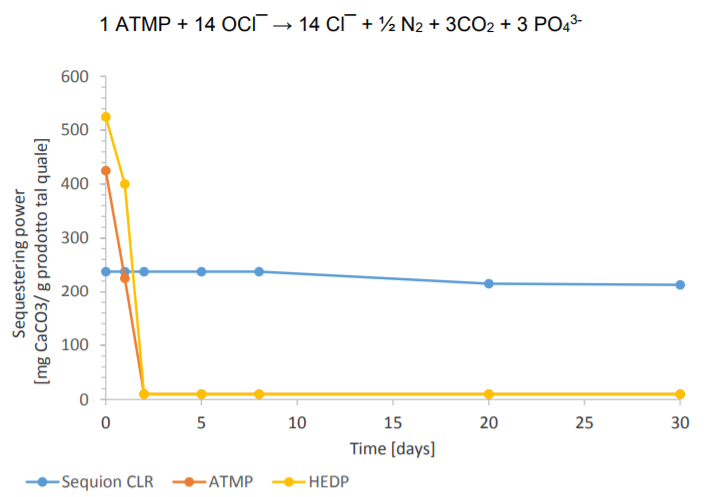
Figure 1. Variation of Sequestering power of Sequion CLR, compared to ATMP and HEDP, when formulated with sodium hypochlorite. Active chlorine concentration in solution: 13%; Concentration of phosphonate (neutralized forms): 10% as product as is. Figure 2 shows chlorine loss (%) of a formulation containing 0.5% of active chlorine and 1% of SEQUION CLR or HEDP or ATMP. The test conditions resembles typical characteristic of a formulation for detergency containing sodium hypochlorite and a chelating agent.
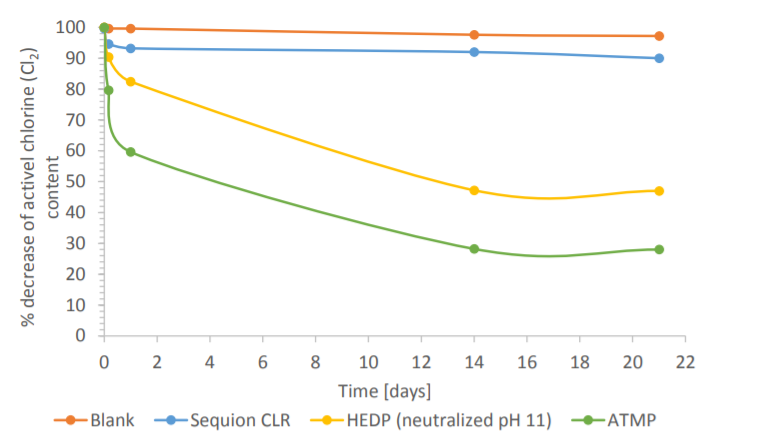
Figure 2. Decrease of active chlorine content with time in a solution containinf sodium Hypochlorite and a Sequion CLR, in comparison with standard phosphonates ATMP and HEDP in neutralized forms. Solution contains: 0.5% active chlorine +1% phosphonate at pH 11. The test has been performed along a period of 21 days, keeping the solution at room temperature and stored in dark place. Sequion CLR does not react with sodium hypochlorite contained in the formulation, in fact the content of Cl2 in solution containing this product remain stable along the period of the test and very similar to the one detected on blank solution (reference without phosphonates). On the contrary, HEDP and ATMP molecules are very sensitive to active chlorine, in fact the content of Clz decreases with time. This is due to oxidative reactions taking place between phosphonates molecule and active chlorine, which bring to a progressive consumption of the phosphonate and of the oxidizing agent. Stability to chlorine-releasing agents and to hydrolysis, also at high temperatures, makes SEQUION CLR particularly suitable for some typical applications. We report an indicative test of resistance to the oxidizing action of sodium dichloroisocyanurate (NaDCC), used in dishwashing detergent (Figure 3), in comparison with a classic phosphonate (HEDP). The greater is the NaDCC concentration, the higher is the percentage of loss of HEDP in solution (with consequent formation of PO4" in solution); clearly an undesired reaction occurred between the two ingredients, compromising the efficiency of the formulation. The same result has not been observed with Sequion CLR, that does not decompose in presence of NaDCC.
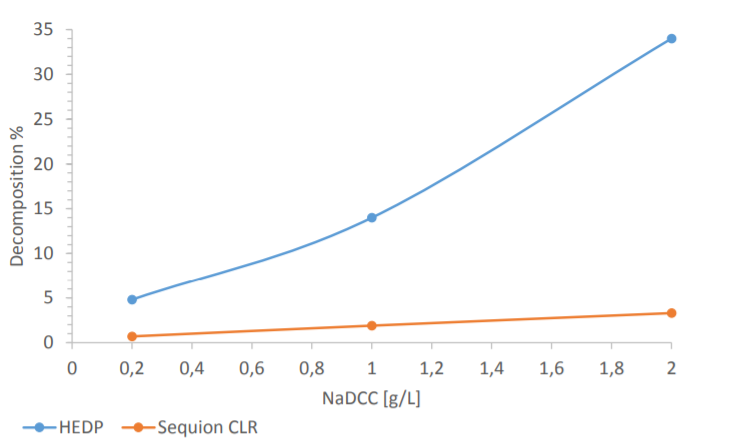
Figure 3 Resistance to oxidative action of NaDCC. Comparison between stability of Sequion CLR and HEDP. Phosphonate dosage: 400 ppm as active molecule; dosage of NabcC: 0.2; 1; 2 glL; temperature: 70°C; time for each test: 30 minutes, pH=12
- Solubility and Handling
SEQUION CLR, besides the complete miscibility in water, has excellent solubility in caustic media and alkaline solutions in general. Figure 4 represents the solubility curve of the product in NaOH solutions of different concentration, at room temperature. SEQUION CLR is a liquid product at pH 10, consequently is easy to be handled, with practically no risk for users during the preparation of the formulations, since the product does not equire a pre-neutralization.
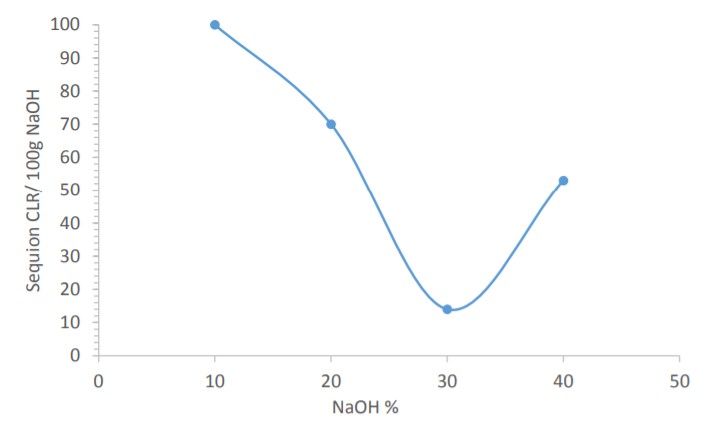 Stability curve of SEQUION CLR blended with NaOH in different concentrations.
Stability curve of SEQUION CLR blended with NaOH in different concentrations.- Threshold Effect
SEQUION CLR can be used in some conditions at substoichiometric concentrations, with great advantages in respect to otheer standard chelating agents, as EDTA or polyphosphates, thanks to its threshold effect. This effect, typical of phosphonates, may be defined as the stabilization of supersaturated solutions (which would normally be expected to contain solid precipitate) by means of substoichiometric concentrations of scale inhibitors. A typical application of the product, which takes advantage of threshold effect, is the use as anti-scale in the rinsing-sanitizing operation of bottle washing, where sodium hypochlorite is used as sanitizer. In this case, the dosage of SEQUION CLR is extremely low, permitting to save money and reduce the content of P in formulation. Figure 5 shows the threshold efficiency of SEQUION CLR in solution containing 100 ppm of CaC03 and 10 ppm active chlorine, in comparison with a classic phosphonate (ATMP).
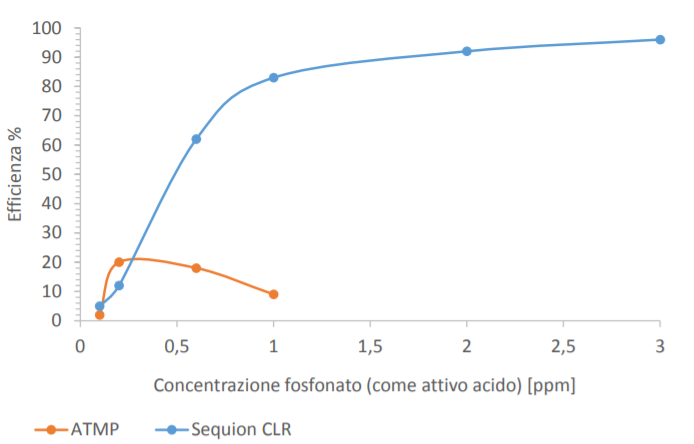
Figure. Threshold effect efficiency for SEQUION CLR and ATMP (neutralized form) in solution containing 100 ppm CaCO3 + 10 ppm of active chlorine; pH 11; solution were kept for 24 hours at a temperature of 70°C for promoting scale precipitation.
- Chelation
SEQUION CLR shows excellent sequestering action; stability constant values of complexes are within the same ranges of those of classic phosphonates. The following table shows the sequestering power values on CalFe at different pH.
pH 9 10 11 12 (*) Ca 200 235 250 265 (**) Fe 140 160 180 120 (*) mg CaCO3/g of product as is (Hampshire test)
(**) mg Fe/g of product as is.In Figure it is represented the CaCO3 sequestering power variation in function of solution pH. The higher is the pH, the higher is the sequestering power.
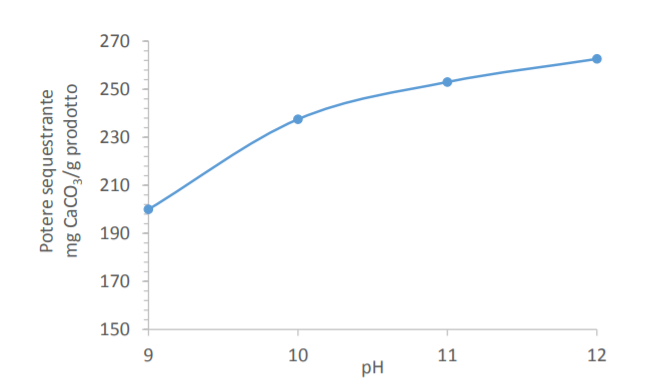
Sequestering power variation with pH for SEQUION CLR
Storage & Handling
- Storage
Storage stability: best at room condition for 12 months. At temperatures lower than 0°C, the formation of white crystals may ocCur, however they can be easily dissolved by brief heating and stirring.
Storage
- mild steel - not suitable
- stainless steel - suitable
- polyethylene - suitable

